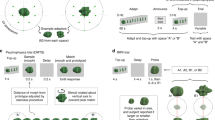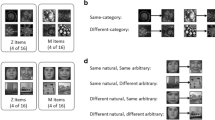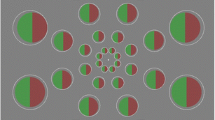Abstract
Several authors have characterized a striking phenomenon of perceptual learning in visual discrimination tasks. This learning process is selective for the stimulus characteristics and location in the visual field. Since the human visual system exploits symmetry for object recognition we were interested in exploring how it learns to use preattentive symmetry cues for discriminating simple, meaningless, forms. In this study, similar to previous studies of perceptual learning, we asked whether the effects of practice acquired in the discrimination of pairs of shape with a specific orientation of the symmetry axis would transfer to the discrimination of shapes with different orientation of symmetry axis, or to shapes presented in different areas of the visual field. We found that there was no learning transfer between forms with very different axes of symmetry (90° apart). Interestingly, however, we found a transfer of learning effect to horizontally oriented symmetry axis from a condition with an axis of symmetry differing by 45°. Also it appears that some subjects took a longer time to learn than the typical “fast learning” paradigm would predict. Data showed that when observers practice discrimination of meaningless symmetric forms, consistent improvement in the performance occurs. This improvement is lasting over days, and it tends to be specific for the area of the visual field trained. We will discuss results from some of the observers whose learning was not “fast”, but who actually improved with more practice and with large time intervals (1 day) between training sessions.
Similar content being viewed by others
References
Atteneave, F.: 1955, ‘Symmetry, Information and for Patterns’,Psychology 68 (August 1955), 209–22.
Ball, K. and Sekuler, R.: 1987, ‘Direction Selective Improvement in Motion Discrimination’,Vision Research 27(6), 953–65.
Barlow, H. B. and Reeves, B. C.: 1978, ‘The Versatility and Absolute Efficiency of Detecting Mirror Symmetry in Random Dot Displays’,Vision Research 19, 783–93.
Chou, I. S.: 1993,The Effects of Object Symmetry and Limits of Learning on Object Recognition by the Perception of Parts, Boston University, Boston Massachusetts.
Deame, M.: 1992,Purposive Vision: An Experimental Approach to Computational Requirements for Theories of Object Recognition, MS Thesis, Biomedical Engineering Department, Boston University.
Deame, M. and Vaina, L. M.: ‘Perception of Object Parts: Local or Global Deformations’,European Conference of Visual Processing, Pisa 1992.
Fiorentini, A. and Berardi, N.: 1980, ‘Perceptual Learning Specific for Orientation and Spatial Frequency’,Nature 287(5777), 43–4.
Fitts, et al.: 1956, ‘A Stimulus Correlates of Visual Pattern Recognition’,Experimental Psychology 51 (July 1956), 1–11.
Gibson, E. J.: 1960,Principles of Perceptual Learning & Development, New York, NY, Appleton-Century-Crofts.
Author information
Authors and Affiliations
Rights and permissions
About this article
Cite this article
Chou, I., Vaina, L.M. Two-dimensional symmetric form discrimination: Fast learning, but notthat fast. Synthese 104, 33–41 (1995). https://doi.org/10.1007/BF01063673
Issue Date:
DOI: https://doi.org/10.1007/BF01063673




